Housing
Good housing is one of the pillars of a thriving city. Having housing for people of all classes is important, and while cities (and suburbs) must include all housing types, there is a glaring shortage of affordable housing that must be dealt with. The interests of low-income people are often overlooked by the for-profit market. It is critical that planners work with politicians, developers, and communities to create more of it and to protect and enhance what already exists. Read more about housing on the Urban Planning page.
A Decade of New Construction of Single Family Houses
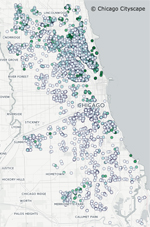 From a Chicago Cityscape newsletter:
From a Chicago Cityscape newsletter:
Single-family houses are about 1/4 of Chicago's housing. Their low-density tranquility can be revered or despised, depending on where it is located and who is expressing the opinion.
Single-family houses may represent affordability and a cohesive neighborhood to Pilsen's long-term residents, or it could represent the loss of multiple units for a single luxurious mansion in Lincoln Park. Some may associate them with the suburbs, or with families. Put on whatever lens you use to interpret single-family houses, because here is over a decade's worth of data about new construction of single family homes.
Rosenwald Court Apartments
 Details about the renovation of the historic Rosenwald Court Apartments were included in a Chicago Cityscape newsletter about sites relating to Black history for Black History Month. The Rosenwald's 421 units were built in 1929 to house people who had arrived in Chicago during The Great Migration. It operated until 2000. Now it is being renovated by a significant task force of developers, funding specialists, preservationists, community outreach consultants, architects, contractors, and more using a coctail of funding sources. Eventually the newly renovated 200+ affordable units and retail/office space will be managed by Mercy Housing.
Details about the renovation of the historic Rosenwald Court Apartments were included in a Chicago Cityscape newsletter about sites relating to Black history for Black History Month. The Rosenwald's 421 units were built in 1929 to house people who had arrived in Chicago during The Great Migration. It operated until 2000. Now it is being renovated by a significant task force of developers, funding specialists, preservationists, community outreach consultants, architects, contractors, and more using a coctail of funding sources. Eventually the newly renovated 200+ affordable units and retail/office space will be managed by Mercy Housing.
The South Loop's Skyscraper Boom
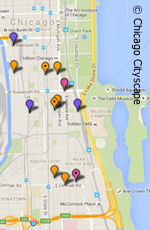 This was one of the most read studies from Chicago Cityscape's newsletter in 2015. It maps out the South Loop's planned skyscraper developments, their heights, and the quantity of housing. Due to this influx of housing, hotels, and other attractions, the South Loop will have a radically different skyline, and an even denser character. The housing is primarily luxury, with some market rate. Affordable housing is not really part of these projets, and the reason that so many of these buildings were pushed through the plan approval process at this point in time was probably because it was right before Chicago's stronger Affordable Requirements Ordinance was about to come into effect (which I explained in another Chicago Cityscape newsletter about affordable housing), and by having these projects approved prior to the stronger ARO laws developers saved thousands, if not millions, of dollars.
This was one of the most read studies from Chicago Cityscape's newsletter in 2015. It maps out the South Loop's planned skyscraper developments, their heights, and the quantity of housing. Due to this influx of housing, hotels, and other attractions, the South Loop will have a radically different skyline, and an even denser character. The housing is primarily luxury, with some market rate. Affordable housing is not really part of these projets, and the reason that so many of these buildings were pushed through the plan approval process at this point in time was probably because it was right before Chicago's stronger Affordable Requirements Ordinance was about to come into effect (which I explained in another Chicago Cityscape newsletter about affordable housing), and by having these projects approved prior to the stronger ARO laws developers saved thousands, if not millions, of dollars.
Demolition, Renovation, and New Construction of Small Masonry Houses
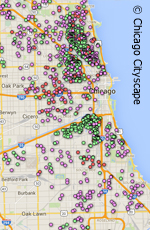 Chicago has many two story residential building styles, including worker's cottages, bungalows, greystones, and two flats. Most are single-family homes, while others are multi-family homes. They comprise a considerable amount of the city's housing stock, particularly in certain neighborhoods, and yet not much attention is given to them because they are such ordinary, modest structures.
Chicago has many two story residential building styles, including worker's cottages, bungalows, greystones, and two flats. Most are single-family homes, while others are multi-family homes. They comprise a considerable amount of the city's housing stock, particularly in certain neighborhoods, and yet not much attention is given to them because they are such ordinary, modest structures.
The map and report for Chicago Cityscape illustrates the new construction (green), renovation (purple), and demolition (red) of two story masonry residences in Chicago. The data comes from permits filed between January 1 2006 and August 29 2015.
FLATS Developer Triples Uptown Property
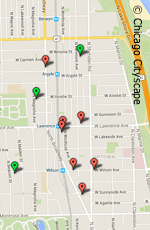 FLATS is a real estate company that manages trendy micro-units. Micro-units are great ways to build densely, a sustainable form of living that also makes public transportation viable. However, space is smaller and these units are typically best for single people living without roomates or many posessions.
FLATS is a real estate company that manages trendy micro-units. Micro-units are great ways to build densely, a sustainable form of living that also makes public transportation viable. However, space is smaller and these units are typically best for single people living without roomates or many posessions.
FLATS has a history of redeveloping SROs (Single Resident Occupancy hotels, which are a form of affordable housing) into market rate (and higher) units, sometimes displacing these lower income residents. But: FLATS also tends to renovate landmarks and landmark-worthy older buildings that otherwise would remain vacant and perhaps be cursed to a demolition by neglect. However you view FLATS, know that they are working to triple the property that they manage in Uptown. I did this study for Chicago Cityscape's newsletter.
Lathrop Homes Memo
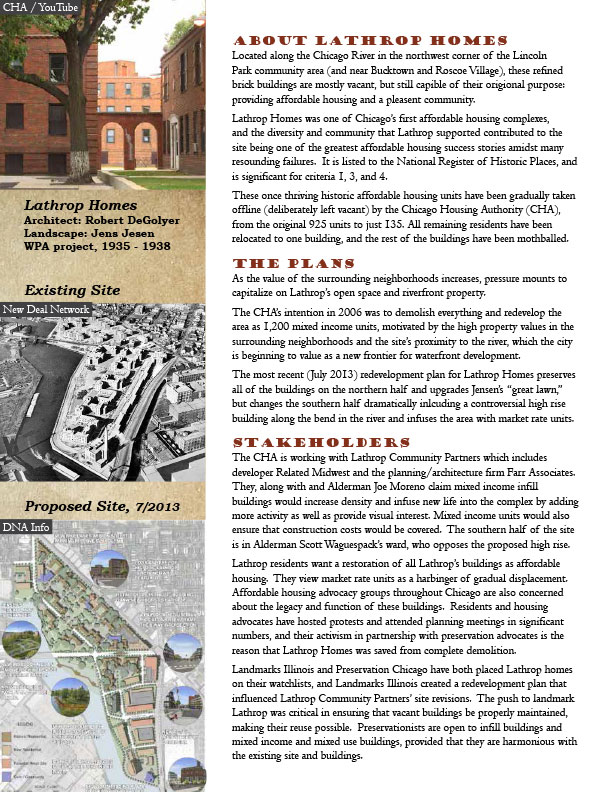 Farr Associates and Related Midwest are working on a redevelopment of Lathrop Homes -- a historically successful series of buildings containing affordable and public housing that have been recently mismanaged by the Chicago Housing Authority (CHA) . It is a controversial project: the residents, neighbors, developers, architects, CHA, and preservationists (to name a few) all have strong opinions about what must be done to make this site a success in the future. This memo summarizes the situation, plan, and positions of stakeholders.
Farr Associates and Related Midwest are working on a redevelopment of Lathrop Homes -- a historically successful series of buildings containing affordable and public housing that have been recently mismanaged by the Chicago Housing Authority (CHA) . It is a controversial project: the residents, neighbors, developers, architects, CHA, and preservationists (to name a few) all have strong opinions about what must be done to make this site a success in the future. This memo summarizes the situation, plan, and positions of stakeholders.
Affordable Housing in Historic Districts: Pilsen
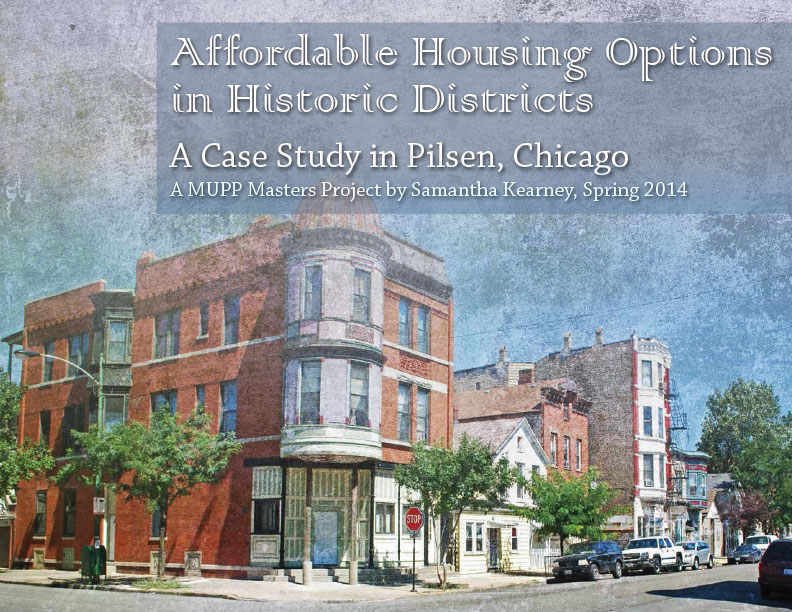 This project examines ways that affordable housing can be encouraged in historic districts, using Chicago's Pilsen neighborhood as a case study. This project illustrates how one may use various incentives to renovate an apartment building, and also a proposal for a Workers Cottage Initiative, which would be similar to the Chicago Historic Bungalow Association and the Greystone Initiative. This report contains:
This project examines ways that affordable housing can be encouraged in historic districts, using Chicago's Pilsen neighborhood as a case study. This project illustrates how one may use various incentives to renovate an apartment building, and also a proposal for a Workers Cottage Initiative, which would be similar to the Chicago Historic Bungalow Association and the Greystone Initiative. This report contains:
- GIS maps of the distribution of affordable housing in Chicago
- GIS maps of Chicago's local & national historic districts and significant properties
- a community assessment of Pilsen
- a chart of incentives showing benefits, eligibility, and project requirements
Age Friendly Berwyn
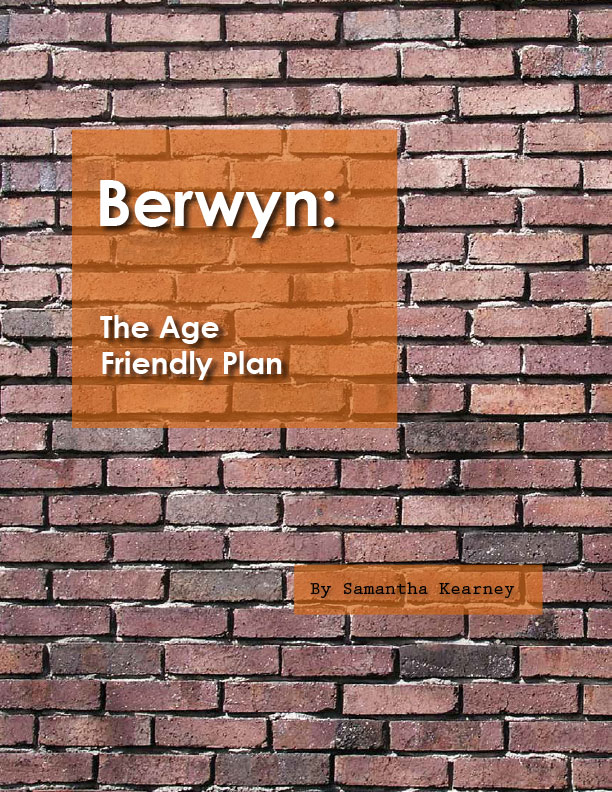 The goal of this plan is to identify ways that Berwyn, IL can be made more hospitable for senior citizens. One of the ways this is accomplished is through improving the dominant form of housing: bungalows. By doing so, people will be able to safely age in place (the most popular lifestyle chosen by seniors) instead of moving to retirement homes (though these are also covered in the plan). The reason for this is that the rooms in bungalows are primarily on a single floor, and if ramps, tripping hazards, ample lighting, and energy efficient methods are used, then these houses will be very age friendly, while also increasing their affordability - which is important to a demographic with limited incomes.
The goal of this plan is to identify ways that Berwyn, IL can be made more hospitable for senior citizens. One of the ways this is accomplished is through improving the dominant form of housing: bungalows. By doing so, people will be able to safely age in place (the most popular lifestyle chosen by seniors) instead of moving to retirement homes (though these are also covered in the plan). The reason for this is that the rooms in bungalows are primarily on a single floor, and if ramps, tripping hazards, ample lighting, and energy efficient methods are used, then these houses will be very age friendly, while also increasing their affordability - which is important to a demographic with limited incomes.
Other methods are also explored, including complete streets and social services. The entire plan is evaluated using the WHO's Checklist of Essential Features of Age Friendly Cities.